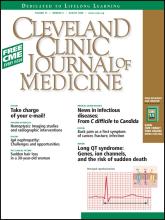Table of Contents
From the Editor
- Upgrades to our CME test and to www.ccjm.org
We recently upgraded our Web-based manuscript tracking system, and we are continuing to expand and improve our educational offerings to our readers.
Review
- Identifying serious causes of back pain: Cancer, infection, fracture
Most patients with back pain have a benign condition, but tumors, infections, and fractures must be considered during an initial evaluation because overlooking them can have serious consequences.
The Clinical Picture
- Sudden hair loss associated with trachyonychia
A 30-year-old woman has been having episodes of sudden hair loss in well-demarcated areas of her scalp for the past 6 months. What is the most likely diagnosis?
Review
- IgA nephropathy: Challenges and opportunities
We now have a reasonably complete understanding of the pathogenesis of this disease, but its etiology remains mysterious, its therapy remains largely empiric, and its course remains hard to predict. Many opportunities exist for improvement.
- Take charge of your e-mail!
Although e-mail is supposed to help people save time, for many it has become a burden. You can fight e-mail overload by taking steps to decrease the amount of unwanted e-mail you receive and by managing your inbox in an organized manner.
Medical Grand Rounds
- Update in infectious disease treatment
Important studies in infectious disease over the last year cover Clostridium difficile-associated diarrhea, the safety of cefepime, acute sinusitis, Bell palsy, antifungal prophylaxis in patients undergoing chemotherapy, and invasive candidiasis.
Review
- Congenital long QT syndrome: Considerations for primary care physicians
We now know more about the genetic basis of different types of long QT syndrome and their clinical implications. In one type, patients can die suddenly during exercise, in another, during inactivity, and in a third, when startled, such as by an alarm clock. The right therapy can dramatically reduce the risk.
Imaging in Practice
- A 44-year-old man with hemoptysis: A review of pertinent imaging studies and radiographic interventions
What imaging tests would be helpful in this patient’s evaluation? We outline our approach.




